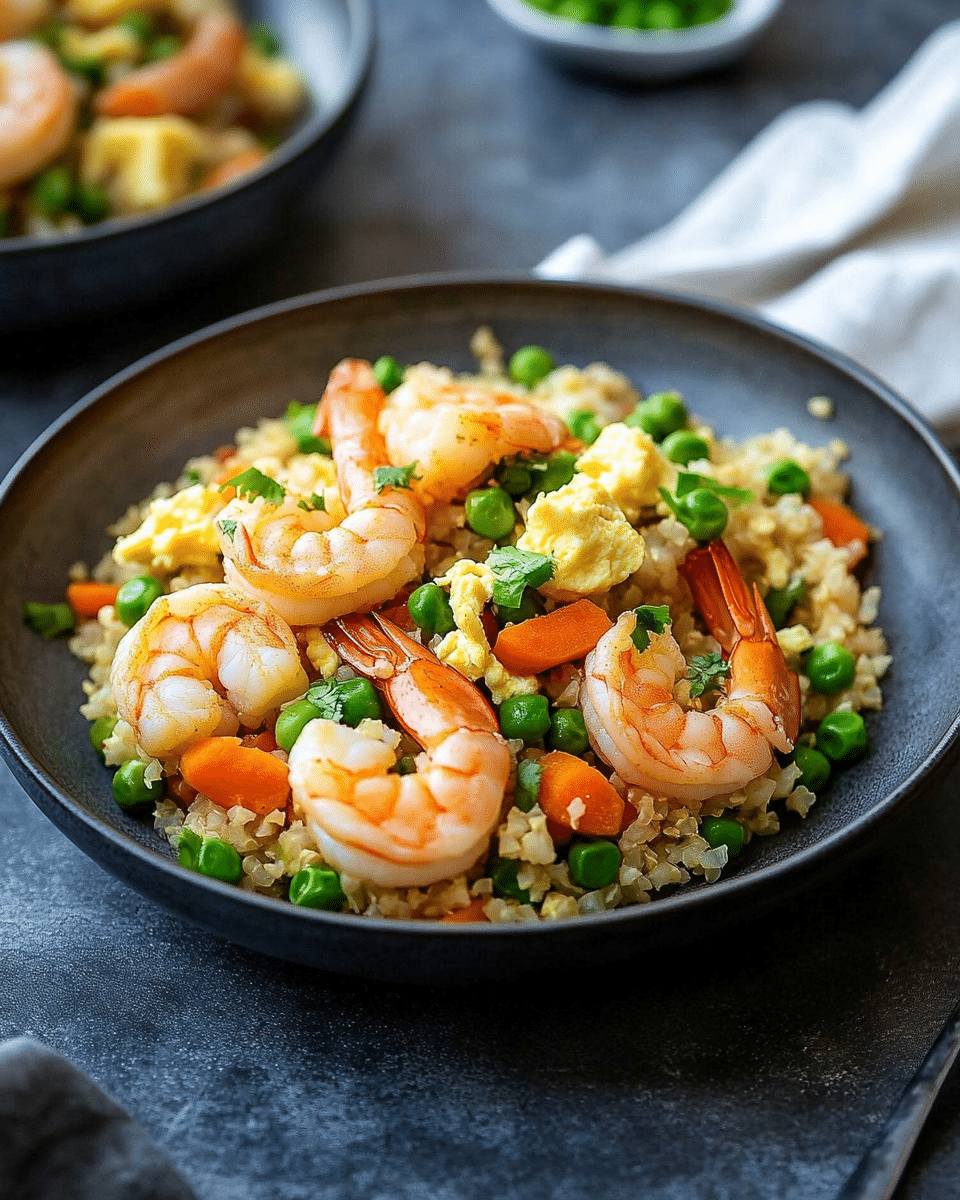This Cauliflower Fried Rice with Shrimp is a low-carb, high-protein twist on the classic takeout favorite.
FULL RECIPE
Ingredients
- 1 lb (450g) raw shrimp, peeled and deveined
- 4 cups cauliflower rice (fresh or frozen)
- 2 tablespoons sesame oil (divided)
- 1 small onion, diced
- 2 garlic cloves, minced
- 1 cup frozen peas and carrots mix
- 2 eggs, lightly beaten
- 3 tablespoons low-sodium soy sauce or tamari
- 1 tablespoon oyster sauce (optional for extra flavor)
- 2 green onions, chopped
- Salt and pepper to taste
- Red pepper flakes (optional for heat)
Directions
- Heat 1 tablespoon of sesame oil in a large skillet or wok over medium-high heat.
- Add shrimp and cook for 2–3 minutes on each side, or until pink and cooked through. Remove and set aside.
- In the same pan, add the remaining sesame oil. Sauté onion for 2 minutes until translucent.
- Add garlic and the peas and carrots mix. Cook for another 2–3 minutes until vegetables are heated through.
- Push vegetables to one side of the pan and pour in the beaten eggs. Scramble until fully cooked, then mix with the veggies.
- Add the cauliflower rice and stir-fry for 5–7 minutes until tender and slightly golden.
- Return the cooked shrimp to the pan, then add soy sauce, oyster sauce (if using), salt, pepper, and red pepper flakes. Mix well.
- Remove from heat, garnish with green onions, and serve hot.
Nutritional Information
- Calories: 265
- Protein: 28g
- Carbohydrates: 12g
- Dietary Fiber: 4g
- Sugars: 4g
- Total Fat: 12g
- Saturated Fat: 2g
- Cholesterol: 210mg
- Sodium: 720mg
- Potassium: 620mg
Health Benefits of Cauliflower Fried Rice with Shrimp
Cauliflower fried rice with shrimp offers a nutritious alternative to traditional fried rice by replacing carb-heavy white rice with cauliflower, a low-calorie vegetable rich in vitamins and fiber. Shrimp adds a lean source of protein and essential minerals like selenium and iodine. This combination promotes muscle health, supports immune function, and aids in weight management by providing filling nutrients without excessive calories or carbohydrates.
Why Cauliflower Is a Great Rice Substitute
Cauliflower is an excellent rice substitute due to its low carbohydrate content and high fiber levels. It provides antioxidants like vitamin C and phytonutrients that contribute to overall health. Cauliflower’s mild flavor and texture make it versatile in recipes, absorbing seasonings well. This vegetable also helps regulate blood sugar levels, making it suitable for those with diabetes or anyone seeking to reduce refined carb intake.
Shrimp as a Protein Powerhouse
Shrimp is a lean, high-quality protein source packed with essential nutrients such as vitamin B12, zinc, and omega-3 fatty acids. These nutrients support brain function, cardiovascular health, and reduce inflammation. Shrimp is also low in calories and fat, which helps in maintaining a healthy weight while providing necessary amino acids for muscle repair and growth.
The Role of Vegetables in the Dish
The inclusion of peas, carrots, and green onions enhances the nutritional profile of this dish by adding fiber, vitamins, and minerals. These vegetables contribute antioxidants that protect cells from oxidative damage and support digestive health. Their natural sweetness balances the savory flavors and adds texture, making the dish more satisfying and colorful.
Cooking Techniques for Optimal Flavor and Nutrition
Stir-frying at high heat retains the crunchiness and nutrients of the vegetables while caramelizing their natural sugars for enhanced flavor. Using sesame oil imparts a nutty aroma and provides healthy fats that aid in nutrient absorption. Scrambling eggs into the dish adds protein and richness, creating a balanced and flavorful meal without the need for heavy sauces.
Customizing the Recipe for Dietary Preferences
This recipe is highly adaptable for various dietary needs. For a gluten-free option, use tamari or coconut aminos instead of soy sauce. Vegetarians can replace shrimp with firm tofu or tempeh for a plant-based protein source. Adding different vegetables like bell peppers, broccoli, or mushrooms can tailor the dish to seasonal availability or personal taste.
The Importance of Low-Sodium Alternatives
Using low-sodium soy sauce or tamari helps control sodium intake, reducing the risk of high blood pressure and related heart conditions. Excessive sodium can lead to fluid retention and strain the cardiovascular system. Incorporating fresh ingredients and natural seasonings allows for flavorful dishes without relying on excessive salt.
Meal Prep and Time-Saving Benefits
Cauliflower fried rice with shrimp is an ideal dish for meal prepping due to its quick cooking time and easy storage. It reheats well, maintaining texture and flavor, making it perfect for busy weekdays. Preparing the cauliflower rice and shrimp in advance can cut cooking time significantly, supporting a healthy lifestyle even with a hectic schedule.
How This Recipe Fits into Low-Carb and Keto Diets
Because cauliflower is low in carbs and high in fiber, this dish aligns well with low-carb and ketogenic diets. Shrimp adds protein without extra carbs, supporting muscle maintenance and fat loss goals. This recipe provides a satisfying meal option for those limiting grain intake while still craving the flavors and textures of fried rice.
Sustainability Considerations
Choosing sustainably sourced shrimp helps reduce environmental impact and supports ocean health. Overfishing and poor aquaculture practices threaten marine ecosystems, so opting for certified sustainable seafood contributes to responsible consumption. Using seasonal vegetables also supports local agriculture and reduces carbon footprints.
Flavor Profile and Culinary Appeal
The combination of savory soy sauce, aromatic garlic, and toasted sesame oil creates a rich, umami flavor that enhances the natural sweetness of shrimp and vegetables. The slight crunch from fresh vegetables contrasts with the tender shrimp and fluffy cauliflower rice, delivering a satisfying mouthfeel. This dish’s balance of flavors and textures makes it appealing to a wide range of palates.
Pairing Suggestions and Serving Ideas
Cauliflower fried rice with shrimp can be enjoyed as a standalone meal or paired with light sides such as a fresh cucumber salad or steamed greens. For added texture and flavor, sprinkle toasted sesame seeds or chopped peanuts on top. A squeeze of lime or a drizzle of chili sauce can add brightness and spice, allowing diners to customize their experience.
Common Mistakes to Avoid When Cooking This Dish
Overcooking shrimp can make it rubbery and tough, so it’s important to cook it just until pink and opaque. Similarly, over-steaming cauliflower rice can result in a mushy texture, losing the desired bite. Using high heat and quick stir-frying helps maintain the integrity of the ingredients. Also, be cautious with soy sauce amounts to prevent the dish from becoming too salty.
Conclusion
Cauliflower fried rice with shrimp is a delicious, nutritious, and versatile dish that fits well into a variety of dietary lifestyles. It leverages the health benefits of cauliflower and shrimp while delivering bold flavors through simple cooking techniques. This recipe supports wellness goals, sustainability, and culinary creativity, making it a great addition to any meal rotation. Whether for a quick weeknight dinner or a meal prep favorite, it offers a satisfying and wholesome way to enjoy a classic comfort food reinvented.






